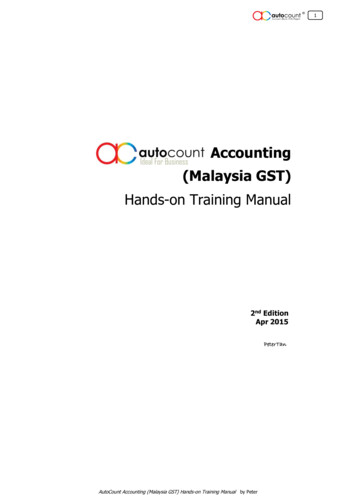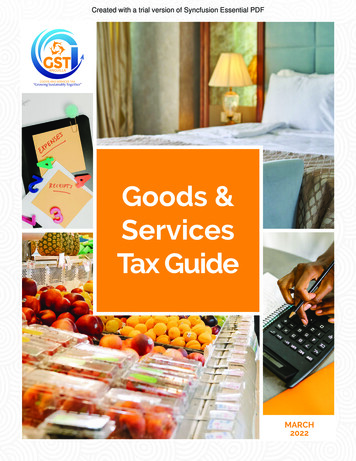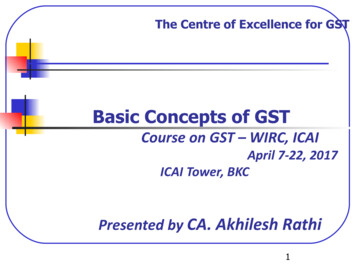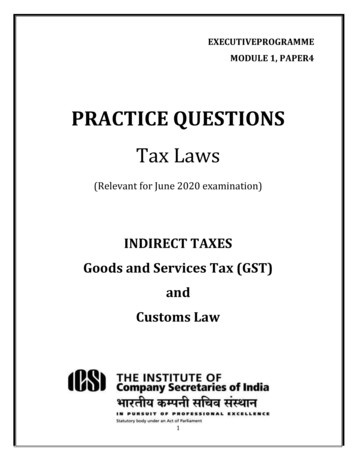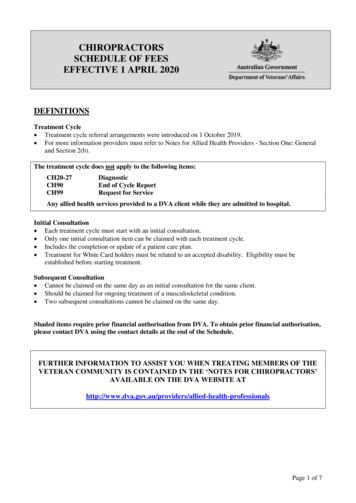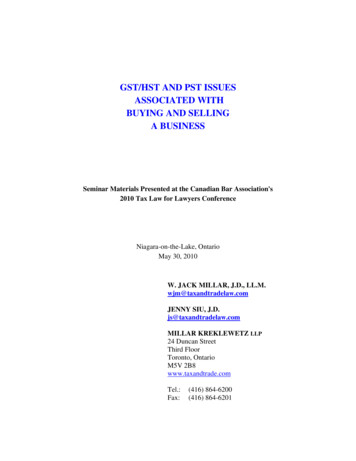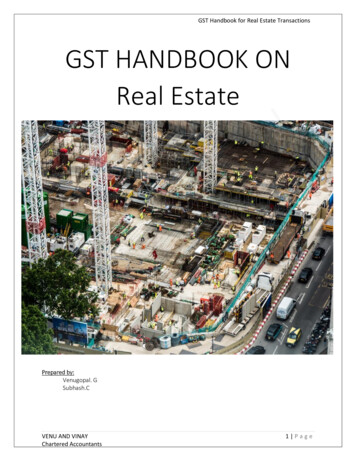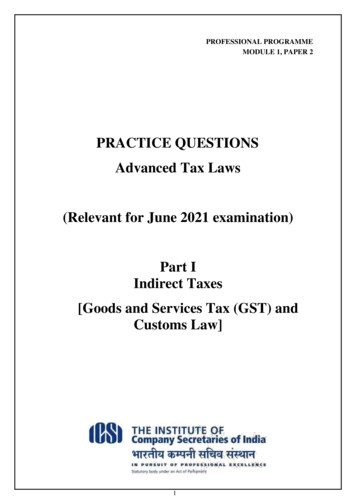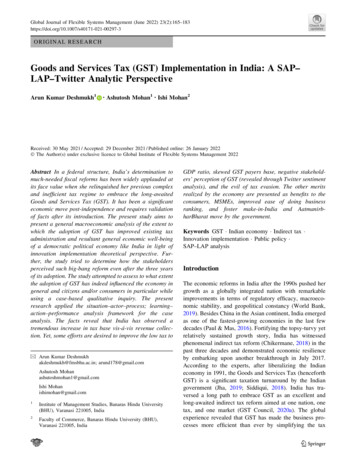
Transcription
Global Journal of Flexible Systems Management (June 2022) 00297-3ORIGINAL RESEARCHGoods and Services Tax (GST) Implementation in India: A SAP–LAP–Twitter Analytic PerspectiveArun Kumar Deshmukh1 Ashutosh Mohan1 Ishi Mohan2Received: 30 May 2021 / Accepted: 29 December 2021 / Published online: 26 January 2022Ó The Author(s) under exclusive licence to Global Institute of Flexible Systems Management 2022Abstract In a federal structure, India’s determination tomuch-needed fiscal reforms has been widely applauded atits face value when she relinquished her previous complexand inefficient tax regime to embrace the long-awaitedGoods and Services Tax (GST). It has been a significanteconomic move post-independence and requires validationof facts after its introduction. The present study aims topresent a general macroeconomic analysis of the extent towhich the adoption of GST has improved existing taxadministration and resultant general economic well-beingof a democratic political economy like India in light ofinnovation implementation theoretical perspective. Further, the study tried to determine how the stakeholdersperceived such big-bang reform even after the three yearsof its adoption. The study attempted to assess to what extentthe adoption of GST has indeed influenced the economy ingeneral and citizens and/or consumers in particular whileusing a case-based qualitative inquiry. The presentresearch applied the situation–actor–process; learning–action–performance analysis framework for the caseanalysis. The facts reveal that India has observed atremendous increase in tax base vis-à-vis revenue collection. Yet, some efforts are desired to improve the low tax to& Arun Kumar Deshmukhakdeshmukh@fmsbhu.ac.in; arund178@gmail.comAshutosh Mohanashutoshmohan1@gmail.comIshi Mohanishimohan@gmail.com1Institute of Management Studies, Banaras Hindu University(BHU), Varanasi 221005, India2Faculty of Commerce, Banaras Hindu University (BHU),Varanasi 221005, IndiaGDP ratio, skewed GST payers base, negative stakeholders’ perception of GST (revealed through Twitter sentimentanalysis), and the evil of tax evasion. The other meritsrealized by the economy are presented as benefits to theconsumers, MSMEs, improved ease of doing businessranking, and foster make-in-India and AatmanirbharBharat move by the government.Keywords GST Indian economy Indirect tax Innovation implementation Public policy SAP–LAP analysisIntroductionThe economic reforms in India after the 1990s pushed hergrowth as a globally integrated nation with remarkableimprovements in terms of regulatory efficacy, macroeconomic stability, and geopolitical constancy (World Bank,2019). Besides China in the Asian continent, India emergedas one of the fastest-growing economies in the last fewdecades (Paul & Mas, 2016). Fortifying the topsy-turvy yetrelatively sustained growth story, India has witnessedphenomenal indirect tax reform (Chikermane, 2018) in thepast three decades and demonstrated economic resilienceby embarking upon another breakthrough in July 2017.According to the experts, after liberalizing the Indianeconomy in 1991, the Goods and Services Tax (henceforthGST) is a significant taxation turnaround by the Indiangovernment (Jha, 2019; Siddiqui, 2018). India has traversed a long path to embrace GST as an excellent andlong-awaited indirect tax reform aimed at one nation, onetax, and one market (GST Council, 2020a). The globalexperience revealed that GST has made the business processes more efficient than ever by simplifying the tax123
166Global Journal of Flexible Systems Management (June 2022) 23(2):165–183structure and reducing the number of state and centrallevies (Nutman et al., 2021). GST is an indirect and destination-based tax. It appears to have influenced the consumers indirectly and directly impacted the businesses(Fernando & Chukai, 2018); however, its ripple effect isbeing felt across the three core sectors of the economy (Jha,2019).The complexities and inefficiencies of previous taxregimes in India (Roychowdhury, 2012) compelled theauthorities to convert the decade-long discussion intoreality. The shortcomings were primarily characterized bycascading turnover taxes between the center and states inthe federal structure, making the regime less comprehensive (Rao & Chakraborty, 2010). The central and statelevies had some inherent limitations, such as central taxescould not cover the value addition in goods outside themanufacturing stage, including a few listed services(Deloitte, 2020; Roychowdhury, 2012). To transform theindirect taxation system, GOI had introduced the longawaited Goods and Services Tax or GST in July 2017.Sensing its magnificence, FICCI (2021) called it a big bangeconomic reform after independence. Despite all meritsand demerits of the Indian GST implementation, littleunderstanding exists of its influence on the economy (Kir,2021) in general from the perspective of the stakeholders.Also, a little understanding was observed in the existingbody of knowledge, particularly on innovation implementation in the emerging Indian public policy domain eventhough GST roll-out to be a process innovation in theeconomic system. It calls for research in the identified fieldabout how fruitful was the introduction and implementation of GST in the economy and the response patterns ofthe stakeholders.The present study aims to analyze the extent to whichthe implementation of GST has improved exiting indirecttax administration and the general economic state of ademocratic political economy like India. The way stakeholders have perceived such big-bang economic reformafter three years. A theoretical perspective of innovationimplementation was applied, citing the context andknowledge gaps concerning a public policy measure in adeveloping economy. Thus, it attempts to answer twodiverse research questions (RQs):RQ1. How has the implementation of GST affectedIndia’s general economic scenario? andRQ2. How have various stakeholders perceived the newtax regime?The nature of the research questions asked determinesthe epistemological ground for the research (Saunderset al., 2019). The core aspect of questions mentioned abovepredominantly belongs to the interpretive paradigm, whichrequires selecting appropriate methods justifying123constructivist ontology (Saunders et al., 2019). The SAP–LAP analysis-backed qualitative case-based inquiry meetsthe methodological and contextual requirements.The study is organized in various sections and subsections comprising a literature review about GST, innovation implementation, and SAP–LAP analysis followedby research methods comprising how SAP–LAP analysis isperformed with its framework to answer the above researchquestions. The result and discussion section elaborates thedetailed analysis and interpretation of individual components of the SAP–LAP framework concerning GSTimplementation.Review of LiteratureThis section presents a literature review about GST andindirect taxes, innovation implementation, and SAP–LAPanalysis under three sub-sections followed by motivationfor this research and gap analysis.Literature on GST and Indirect TaxesIn public finance, taxes are usually collected as significantrevenue sources as direct and indirect taxes. The taxes paiddirectly by the public, such as corporate income tax,income tax, wealth tax, are referred to as direct taxes. Incontrast, indirect tax is essentially consumption-based taxsuch as value-added tax or VAT, service tax, and customs.The revenues from indirect taxes are shared jointly by thecentral and state government and some local bodies in thefederal structure. In contrast, direct taxes are the centralgovernment’s subject matter. France implemented GST in1954, and the same was followed by over 100 countries,including several emerging economies such as Brazil,China, and now India (Kir, 2021), after observing itsdemonstrated success across the globe. Economists notedthat a country’s development hinges upon the mobilizationof tax revenue (Dabla-Norris et al., 2017; Schlotterbeck,2017). It is pertinent to ensure stable tax revenues to meetthe significant budgetary heads such as healthcare, infrastructure, and education. The increasing tax revenue leads toeconomic growth and development (Besley and Persson,2009; Gaspar et al., 2016; Milios, 2021). Also, enhancingtax collection is crucial (Akitoby et al., 2018; Fenochietto& Pessino, 2013) to attain the Sustainable DevelopmentGoals (SDGs) propounded by United Nations. Therefore,an economy is expected to have an efficient tax policy andadministration. However, the tax structure differs acrossthe continents and countries (Besley & Persson, 2009;Fenochietto & Pessino, 2013). Sindzingre (2007) pinpointed that Asian developmental states do not rely on highlevels of taxation, which is characterized by their capacity
Global Journal of Flexible Systems Management (June 2022) 23(2):165–183to commit and intervene credibly in policies directedtoward growth rather than a tax.Research by Onaolapo et al. (2013) revealed that theadoption of value-added tax showed a statistically significant influence on revenue generation in the Nigerian context. The study also pinpointed the need for dedicated andintegrated efforts from the stakeholders to improve VATcollections. The study also analyzed how value-added taximpacted revenue generation in Nigeria. They asserted thatthe consumption-based taxes should be assessed on different considerations such as administrative feasibility,relative revenue potential, voluntary compliance, for betterimplementation. These considerations also equally apply toGST implementation.Some of the cross-sectional studies with panel data andcase studies were conducted to analyze the impact of sociopolitical determinants, tax policy, economic dynamics, andeconomic structure in an economy (Garg, 2019; Kir, 2021;Kulkarni, & Apsingekar, 2021). Plenty of studies unveiledthe relationship among factors influencing the revenueoutcome while highlighting the complexities in separatingthe relevant determinants (Crandall & Kidd, 2006; Dom,2018, 2019). The study conducted by Gupta (2007)explored the relationship between economic developmentand the structure of the tax revenue realization in developing countries and asserted a positive correlation betweenper capita GDP and revenue.Research by Dabla-Norris et al. (2017) evaluated thefirm performance changes due to the tax compliance burden in 21 countries using VAT and corporate tax rates tocontrol tax policy. Investigating the effect of tax policychanges on revenues, the study also emphasized on anassociation between policy reforms and revenue growth inthe emerging economies (Akitoby et al., 2018) and maintained that policy reforms can be increased with the risingrate of indirect tax, changing the type of tax being levied,and decreasing level of exemptions. The studies measuringthe impact of VAT found mixed results as some observedgrowth in the revenue (Ebeke et al., 2016; Schlotterbeck,2017) while others found it insignificant (Ngoma & Krsic,2017). Some studies emphasized how socio-political factors determine the extent of revenue collected relative toGDP and asserted that the Gini coefficient was negativelycorrelated with the revenue collections (Fenochietto &Pessino, 2013). Nonetheless, not enough literature could belocated in the Indian context expounding implementing atax administration policy and associated indicators.The early research analyzing the impact of GSTimplementation on the Indian economy was limited andutilized only nascent and generic indicators (Bindal &Gupta, 2018; Dash, 2017; Mishra, 2018) to demonstratewhether GST has attained the desired outcome afterimplementation. The other studies were highly sectoral and167regional (Garg, 2019; Kulkarni & Apsingekar, 2021). Inaddition, expounding the situation after the implementationof GST, The New Indian Express (2021), in its report onGST, mentioned that the government’s bonafide intentionsback GST yet, technical glitches and design-related flawscaused ineffective execution during its early phase. Thetechnical malfunction also caused fake invoicing by somebusiness enterprises. Despite all advantages, some significant implementation flaws include technical glitches, frequent changes in the rules, malfunction of input tax creditclaim system, multiple tax slabs and frequent changes initems covered under these slabs, etc. (Financial Express,2019; The New Indian Express, 2021). Many businesseshave to confront multiple litigations due to a lack of clarityon various rules and their varied interpretations in differentstates. This aroused interest in conducting the study tounearth several theoretical and practical learnings that maylead to future research.Having cited the above literature, the researchersobserved a lack of primary and secondary literature linkingindirect tax reform in an economy and its economic impact.The studies cited primarily belong to tertiary literature,which was used to establish the viewpoint. However, dueto the nascent stage of GST implementation in India, itbecomes difficult to deploy quantitative panel data analysis. Therefore, the study analyzed GST implementation inthe economy using a factual SAP–LAP qualitative framework and Twitter sentiment analysis using the stakeholders’ perception mapping. It was an exploratory inquiry toadvance understanding of a less explored phenomenon withan innovation implementation-led theoretical perspective.Literature on Innovation ImplementationConsidering GST as a process innovation in a macroeconomic context, the present research cited relevant studies toanalyze the status of GST after three years of implementation. The previous research on innovation implementation revolves primarily around the organizational contexts(Chung et al., 2017; Damanpour & Schneider, 2006; Dhiret al., 2020; Malaviya & Wadhwa, 2005; Singh et al.,2021a, b), with a slight possibility for being adapted in thecontext of an economy. An economy akin to an enterpriseneeds to constantly innovate its key processes to sustainand be competitive in a contemporary environment characterized by ever-changing technology and handling ofeconomic operations (Chung et al., 2017; KrawczykSokolowska et al., 2021). Emerging economies such asIndia possess numerous possibilities for innovation onseveral fronts including the micro- and macro-level (Dhiret al., 2020, 2021). Past studies have shown that innovationkeeps the system competitive and is necessary to propel123
168Global Journal of Flexible Systems Management (June 2022) 23(2):165–183superior performance (Birkinshaw et al., 2008; Dhir et al.,2021).Nevertheless, assessing the innovation-specific outcomes is intriguing in a system at both levels. It can beanalyzed with its apparent characteristics, such as theeffectiveness of implementation and point of innovationitself in terms of benefits derived from it (Klein & Sorra,1996 c.f. Chung et al., 2017). It is asserted that approximately two-thirds of the innovations go unsuccessful andpose a financial burden on the system (Altuwaijria &Khorsheed, 2012). The entities implementing the inventionare bound to fail to attain desired benefits due to failure ofinnovation or implementation (Chung et al., 2017).The introduction of GST in India is a process innovationof continuous nature, depending heavily upon the principles of appropriateness, accessibility, and affordability(Fannin, 2016). Also, Singh and Dhir (2021) pointed thatstudies addressing innovation implementation focused onspecific organizational contexts, including manufacturing(Dwivedi et al., 2019; Jamwal et al., 2019),Entrepreneurship (Parameswar et al., 2019; Singh et al.,2019), health (Birken et al., 2015; Pradhan et al., 2019),transportation (Shankar et al., 2019), financial inclusion(Malik et al., 2019), and ERP implementation (Nagpalet al., 2019). However, studies cited in the public policydomain were scanty (Singla & Hooda, 2018; Sushil, 2008;Sushil, 2019, Suri & Sushil, 2012; Suri & Sushil, 2008).The extant literature in this field further revealed that mostof the studies on innovation implementation were conducted in the developed economies and, therefore, exhibitthe strategies adopted in that context, which cannot bereplicated in the emerging economy scenario (Singh et al.,2021a, b). The key differences must be thoroughly analyzed due to contextual variations in terms of demographics, infrastructural, regulatory policies, etc., forensuring implementation of the innovation (Dhir et al.,2020).Further, from the theoretical standpoint, the implementation of innovation literature has widely used dynamiccapability theory to examine how the organization canadapt its knowledge base in response to environmentalchanges (Teece et al., 1997; Teece, 2018 c.f. Singh et al.,2021a, b). The effectiveness of such implementation can bemeasured using the degree to which the desired outcomesare realized (Singh et al., 2021a, b). According to Piening(2011), the implementation of an innovation, technology,or practice necessitates the creation of new routines fordesired outcomes, as was the case of GST, where thegovernment revamped all previous processes (routine). Thesystem continuously tracks the systemic and process-related flaws in GST implementation such as technical glitches, erroneous input-tax credit claim mechanism, multipletax slabs with frequently changing specified items. (The123New Indian Express, 2021). The studies primarily adopteddynamic capability theory (Teece et al., 1997), theresource-based view (Chichkanov et al., 2021), groundedtheory (Deloitte, 2020), etc., to understand the implementation. Yet, studies in public policy-related aspects arelimited in numbers (Singla & Hooda, 2018), requiringfurther investigation to analyze the same. Thus, the previous literature revealed some significant research gaps ininnovation implementation comprising context gap andknowledge or theory gap. The present research aims atbridging such gaps in the context of GST implementationusing an SAP–LAP framework to investigate the degree towhich the GST implementation as a process innovation inpublic policy has impacted the general state of theeconomy.Literature on SAP–LAP AnalysisThe SAP–LAP framework for analysis was initiallydeveloped by Sushil (2000) and Sushil (2001a). The present study uses the SAP–LAP framework (Fig. 1) to analyze the pre- and post-GST implementation scenario toevaluate the system’s efficacy and suggest enhancements.Several scholars in the past applied SAP–LAP analysistools to study such situations and developed valuablesolutions. The selected pioneering and prominent studiesare presented in Table 1, which exhibits the cross-contextand cross-concept use of the technique.The study utilizes a case-based review approach to analyze India’s indirect taxation policy framework and associated indicators. The analysis is performed with aninterpretive method known as SAP–LAP (situation, actor,process and learning, action, performance) frameworkdeveloped by Sushil (2000). The SAP–LAP method waswidely used by the researchers in case-based studies (Anandet al., 2018; Charan, 2012; Chavan et al., 2019; Kanda &Deshmukh, 2007; Anand et al., 2018; Naik & Srivastava,2017; Pramod & Banwet, 2010; Sushil, 2019; Suri & Sushil,2008). As described by Sushil (2009), ‘‘SAP–LAP is a generic framework which can be used in various contexts, suchas problem-solving, change management, be used as generalized statements for the similar cases in the future byproper synthesis’’ (p. 11). SAP–LAP application has notbeen limited to the business verticals only but applied theleast in the public policy domain (Chand et al., 2018; Chavanet al., 2019; Suri & Sushil, 2008).3. Research MethodsThe paper focuses on exploring the present state of GSTimplementation in India by the government on completingits three years. The paper follows SAP–LAP framework-
Global Journal of Flexible Systems Management (June 2022) 23(2):165–183169Fig. 1 SAP- LAP Framework.Source: adapted from Sushil,2014Table 1 Studies on context-specific use of SAP–LAP frameworkAuthorsConceptContextSushil (2000, 2001a, 2001b, 2009)Foundation method studies on SAP–LAPConceptualMajumdar and Gupta (2001)Information managementPassenger carSuri (2005)ICT based good e-governancePublic policyRavi and Shankar (2006)Reverse logistics operationsPaper industryAutomobile repairGarg and Deshmukh (2010)Engineering support issuesShukla et al. (2011)Supply chain coordinationAuto componentsSuri and Sushil (2012)Implementation of eGovernance projectsPublic PolicyJohn and Ramesh (2012a, b); Kabra et al. (2015)Charan (2012)Humanitarian supply chainSupply chain performanceDisaster managementAutomobileMahajan et al. (2013)Manufacturing and supply chainFrozen cornSingh and Shalender (2014)Marketing flexibilityAutomobileVenkatesh et al. (2014)Sourcing practices in manufacturingApparelIyengar et al. (2016)Palliative care processHealthcareKumar et al. (2018)Supply chainCoal transportationMalik et al. (2019)Financial inclusionPublic policyChavan et al. (2019)Progressive urbanization strategyPublic policyKumar and Ambanadam (2020)Supply chain resilienceCase-based123
170Global Journal of Flexible Systems Management (June 2022) 23(2):165–183based qualitative design. The study used a step-by-stepapproach to review extant literature to understand how thepast scholars have conceptualized and theorized such aphenomenon. To critically examine the initiatives aboutindirect taxation and GST mainly, the authors reviewed thepublications of the GST Network, Central Board of IndirectTaxes & customs (CBIC), National Institution for Transforming India (NITI) Aayog, World Bank, InternationalMonitory Fund (IMF), and relevant policy documents. Anattempt was made to pinpoint the gaps and plausibleimplications on business and society by using the excerptsfrom literature and discussing with experts and stakeholders affected by GST implementation. Since the emphasiswas on assuming the implementation at the last mile besidethe experts, the opinions of retailers complying with GSTand consumers who are indirectly paying it were considered. The existing framework gaps were recorded through30 experts, 200 retailers, and 1000 customers. The keycriterion for selecting the respondents was their direct and/or indirect involvement in GST-related regulation orcompliance.More so, to add a qualitative dimension to the SAP–LAP-based research and gauge the sentiments of differentstakeholders on completion of its three years of GST, theauthors have added analyses of tweets, especially as part ofthe situation analysis and learning synthesis. The studyperforms the Twitter analysis of the posts containing #GSTand its associated sentiment analysis to identify how thestakeholders, including the business community vis-à-visthe common public on social media platforms, perceivedthe roll-out and the implementation of GST in India by thegovernment. The researchers performed the data scrappingfrom Twitter with basic Tweepy (Application Programming Interface or API). The application software used inthe process was NVivo (NCapture tool). It enables capturing the tweets using a #hashtag across the timelines. Forthis research, the restriction kept was the tweets with #GSTfrom India. The present study captured one week’s randomtweets after completing three years for analysis. The purpose was to see the polarity of the sentiments after threeyears of GST roll-out in a random data scrapping.SAP–LAP Analysis FrameworkThe SAP–LAP framework for analysis was initiallydeveloped by Sushil (2000). The expansion of the acronymSAP–LAP refers to a situation that indicates the internaland/or external environment. The external environmentmay include social, technological, economic, political, andnatural environmental factors. In comparison, the internalenvironment may consist of organization-specific factorssuch as resources, capabilities, employees, organizationalstructure, and design. When considering India as an entity123for analysis under this framework, the introduction of GSTcan be taken as a constituent of a situation aspect, and itsmacroeconomic, socio-political, technological impacts canbe considered as the external consequences. Further,keeping the temporal orientation into account, the situationcan be referred to as what has happened? what is going on?and what is expected?The actors in the framework are people, agents, orstakeholders directly or indirectly related to the case situation under consideration. They either influence the condition or are affected by the situation. The stakeholdersinvolved are the government, including the finance ministry, administrators, and policymakers in the GST network, business owners or managers, customers or thegeneral public. It is indeed a highly complex web of actorsin one of the largest democracies like India. The thirdaspect in the framework processes refers to how the situation-specific input transforms into output due to thecourses of action initiated by the ’actors.’ The actors enjoythe freedom of choice to transform a situation and bringabout a change in the situation hand. In this context, theGST collection process, refund or input credit process,audit process, taxpayer complaint resolution process, GSTcouncil reform process, etc., are examples of various processes involved. The key actors are expected to strengthenand optimize the strategies to enhance the situationcontinuously.The interaction and synthesis of the situation–actor–process framework guide the learning–action–performanceframework (Sushil, 2000, 2019). The first alphabet in theLAP framework stands for learning, which refers to athorough comprehension of the core issues, problems, andchallenges of SAP. It can be referred to as an outcome ofthe meticulous investigation of the individual componentsvis-à-vis the collective interplay of SAP. The learningcomponent usually includes the generalizable output forexecution or insights on specific situations or objectives.The action is all about converting the learning insights intopractice to eradicate the existing systemic deficiencies. Itmay emphasize enhancing the current processes byimproving efficiency and effectiveness.Moreover, the action component of the framework helpsin the development of some actionable policies or guidelines. The action taken will impact the performance, whichcan be observed through enhanced productivity, efficiency,effectiveness, higher profitability in general and betterfiscal discipline, and resultant higher revenue generation inparticular. It can be inferred that how flexibility in thesystem improves the overall performance (Evans & Bahrami, 2020; Sushil, 2019) and, as a result, how India ranksbetter in terms of governance, ease of doing business, andsystemic transparency by applying the SAP–LAP analysis.
Global Journal of Flexible Systems Management (June 2022) 23(2):165–18317130Results and Discussion25Situation20Low Taxes-to-GDP RatioGross Tax Revenue(in Lac Crore)15% age of GDPThe World Bank statistics (2017–2019) on taxes as a percent of GDP reveals that India needs to increase its share oftaxes in GDP at par with most of its developing counterparts. It further reported that the developed countries’ ratiois greater than 10 percent compared to India’s 7.8 percent(Table 2) and far below the OECD average of 34% (TheEconomic Times, 2020, January). This ratio indicates howwell a government can finance its expenditure, reducing theborrowing. The higher proportion shows faster economicdevelopment as it enhances the government’s ability tofinance the expenditure.The data obtained from the official sources were analyzed and compared with the previous tax regime to answerthe first research question. The analysis is presented inTable 2 and Fig. 2 revealing the government’s fiscalparameters, taxes as a percent of GDP. The answer to thesecond research question is addressed in the upcoming subsection nested in case-based SAP–LAP analysis.Table 2 exhibits the gross and net tax revenue from2014–2015 to 2019–2020 and their share in GDP for thecorresponding year. The above data highlighted the risingrevenue vis-à-vis is rising cost of collection and a corresponding reduction in the net figures from 2017 to 2018,which can be attributed to the GST implementation. In2018–2019, the gross tax to GDP ratio was 10.9, indicatinga 16 percent fall in tax revenue from the budget estimates.The reduction is due to a shortfall in GST collection(Financial Express, 2019). The revenue growth also corresponds to the contribution of GDP figure, which hoversbetween 6 and 8% for net tax revenue, far below expectations. It indicates the need for further improvement toenhance the tax revenue collections.10Net Tax Revenue(in Lac Crore)5% age of GDP0Fig. 2 Taxes as a percent of GDP in Post-GST Era. Source compiledfrom the data accessed from https://www.indiabudget.gov.inComponent-Wise GST CollectionFigure 3 depicts the component-wise GST collections inthe three fiscals from July 1, 2017, to June 2020. In India,the GST council divided GST into three components:Central GST or CGST, State GST or SGST, IntegratedGST or IGST. The CGST represents the share of the centralgovernment, SGST indicates the state government’s claim,whereas IGST is collected on inter-state movement ofgoods and/or delivery of services. As shown in Fig. 3, thecollection of IGST is highest among all across the threeyears, followed by SGST, CGST and cess. The cess is aminor component charged along with GST in India.Lopsided GST PayersThe recent analysis on the contribution of various businessforms in the total GST collection (Fig. 4) reveals that62.8% of GST revenue comes from public and privatelimited companies, accounting for a meager 5.89% of thetotal taxpayer population. The remaining 94.11% of taxpayers contribute 37.2% of the total GST revenue. T
The SAP- LAP analysis-backed qualitative case-based inquiry meets the methodological and contextual requirements. The study is organized in various sections and sub-sections comprising a literature review about GST, inno-vation implementation, and SAP-LAP analysis followed by research methods comprising how SAP-LAP analysis is
